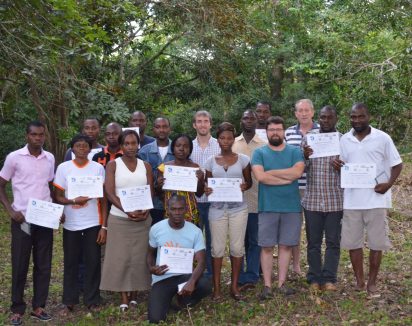
Trainings (of trainers) on soil-dwelling entomofauna inventory and ant, bee & insect taxonomy in Western Africa at Station d’écologie de LAMTO, Ivory Coast
Project details
2013, 2014 and 2015
Ivory Coast
Arthropods - Insects: 1__Animalia – Arthropoda – Insecta – Hymenoptera – Formicidae; 2__Animalia – Arthropoda – Insecta – Hymenoptera: Apoidea
Royal Belgian Institute of Natural Sciences
Station d’Ecologie de Lamto and Centre de Recherche en Ecologie (CRE) – Unité de Formation et de Recherche en Sciences de la Nature (UFR-SN) – Université Nangui Abrogoua
Most countries of Western Africa, such as Ivory Coast, have a megadiverse entomofauna. Nevertheless, entomological diversity, including ants, remains poorly known in these regions. Recent ant surveys by Dr. Yeo Kolo hosted at Lamto ecological station and other sites in Ivory Coast (Yeo, 2006; Yeo et al., 2011) indicated that its entomological and especially its ant fauna is extremely rich, unique and taxonomically important but also that it is sensitive to global changes such as deforestation, climate modification and probably also introduction of invasive species.
Besides general attention for soil-dwelling entomofauna groups, the main focus of the trainings in the proposed projects will be on ants, bees and the other insect fauna of Ivory Coast in general. Ants and bees are among the most informative and tractable groups for biodiversity evaluation and monitoring because they are ecologically and numerically important, sensitive to environmental changes and easy to collect in a standardised way. Unfortunately, in Ivory Coast, ants (Kone et al., 2012) and bees (several publications in prep.) are only recently studied. These recent studies indicate a very diverse fauna which has important implications on other entomofauna groups.
The aims of the 2013 project are to provide to a group of 5-10 biology students hosted at Station d’écologie de Lamto and Université Nangui Abrogoua (ex Abobo Adjamé) UFR-SN, Centre de Recherche en Ecologie:
The aims of the 2014-2015 projects are (1) to provide an in depth training to 5-10 young scientists from Ivory Coast in a first phase (2014) and (2) to provide a training to 5-10 young Western African Trainers in Taxonomy (WATTs) from Ivory Coast as well as other Western Africa countries (like Togo, Sierra Leone and Republic of Guinea) in a second phase (2015). These trainings will enable the participants to develop the skills to:
The WATTs will eventually be able to train young Bachelor and Master students in entomology and the skills mentioned above.
To attain these objectives, the young scientists/WATTs will be supervised by an international team of three experts in entomology (with focus on myrmecology) and collection curation during several days. The courses will combine classroom lectures, laboratory and collection work. It is expected that these high-quality trainings will stimulate local students and future scientists to carry out taxonomical research on entomology and myrmecology, especially within the framework of conservation projects (under supervision of the WATT’s trained).
Video showing the research facilities at the Station d’écologie de Lamto, Côte d’Ivoire, and some of the activities that took place during the training from 19 January to 4 February 2016
Presentations given during the 2015 project at Lamto: